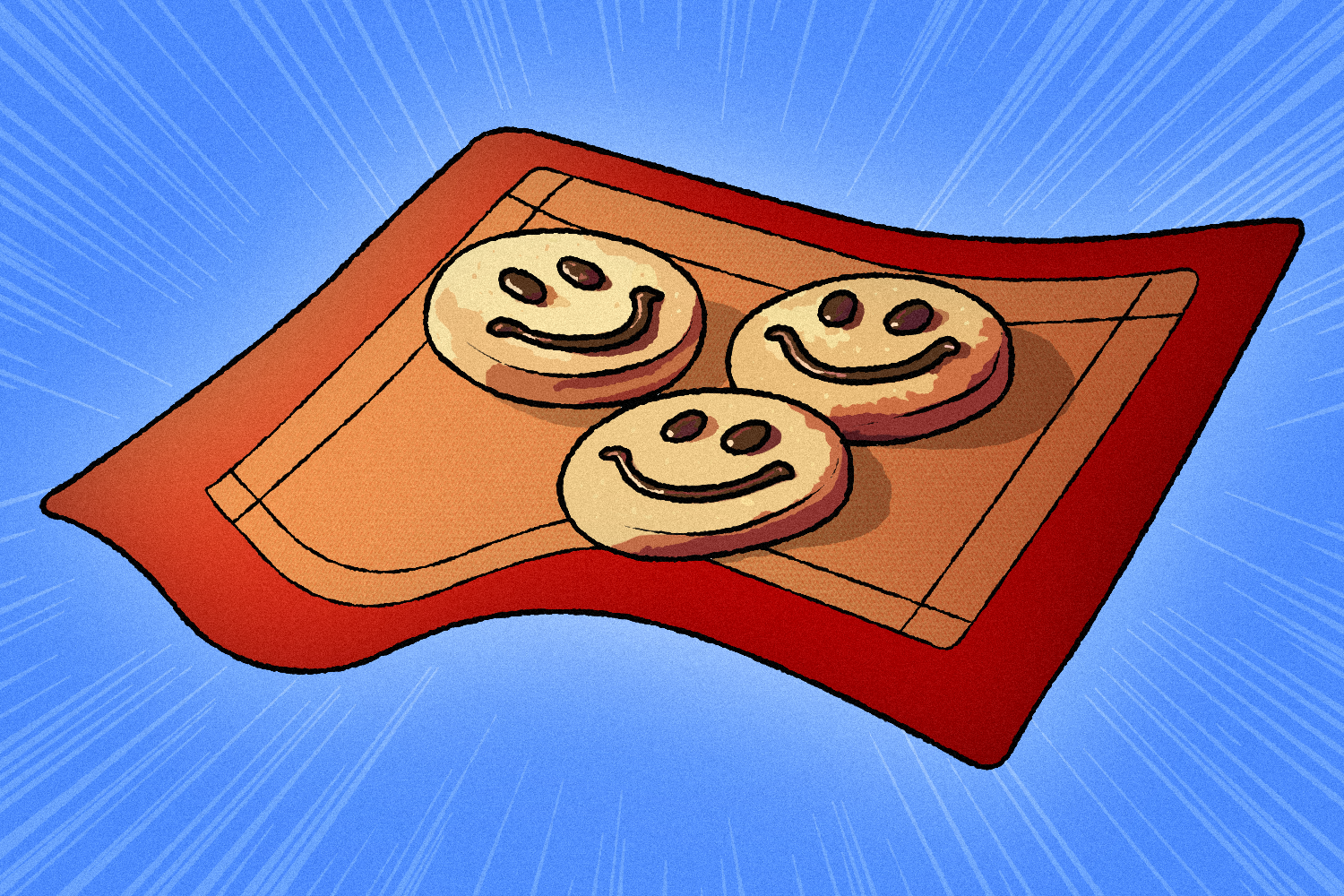HHey team, and welcome back to one5c! We’ve got two helpings of goodness for the waste-conscious among us this morning. The first is our pick for the best silicone baking mat—aka the thing that will help cooks and bakers bid adieu to single-use parchment. This one’s an extra special treat because we asked Cool Beans’ Gabriella Vigoreaux, who co-owns a bakery near her Florida home, to put these mats through their paces.
The second is a reminder to anyone cleaning out their pantry this spring that the dates on food packages are mostly made up—and lead to a lot of food waste. Liza Schoenfein (also of Cool Beans) has the real scoop on when it’s time to chuck any grub. —Corinne
WHAT WE’RE INTO THIS WEEK
By Sara Kiley Watson and Audrey Chan

Consume this
The best silicone baking mat
Parchment paper is a go-to for keeping cookies and savory dishes from sticking to baking sheets, but it’s unfortunately more-than-a-little-bit wasteful. Silicone baking mats, however, can do most of the same tricks, minus the garbage. They fit standard sheet pans, withstand high heat, and are incredibly nonstick. There is, though, plenty of variation from mat to mat, so we spent two months testing six popular options in a professional bakery to find the one that’s not only legit good at everything from cookies to roasted veggies, but that also comes from a company that treats the planet right. Our favorite is a sturdy yet lightweight option that perfectly cozies up in standard sheet trays and delivers batch after batch of well-baked treats. Read the full test here.
Study guide
Humans are nature’s biggest threat
A new analysis in the journal Nature has shown more clearly than ever before that humans are the biggest driver of biodiversity loss around the world. Beyond shrinking the number of species on the planet, human activity is reshaping entire ecosystems. The authors synthesized the results of more than 2,000 studies and found that stressors like climate change, pollution, the introduction of invasive species, and habitat destruction are shifting where species live and cutting populations in affected areas by 20%. These shifts can have big consequences: Earth’s diverse species provide key functions like pollination, decomposition, and seed dispersal, Lynn Dicks, a professor of ecology at Cambridge University who was not involved in the study, told The Guardian. The findings also underscore the importance of conservation in keeping the planet in balance.
Good listen
The untold story of climate rebels
In 2022, activists from U.K. group Just Stop Oil threw tomato soup all over Vincent van Gogh’s famous Sunflowers painting at the National Gallery in London. The work of art remained unharmed behind a protective glass casing, but the act nevertheless put climate protesters under a new microscope. The new Sabotage podcast from Good Luck Media tells the story of this rebellious, messy, and unconventional style of climate activism. In the nine-part series, which kicked off last week, hosts Alessandra Ram and Samantha Oltman dig deeper into this tale, exploring the complex and surprising backstory fueling the secretive group’s shocking stunts.
Cause for optimism
See-through solar panels could help buildings power themselves
The CitySolar project––a collaboration between European academic, research, and industrial partners working to bring solar windows to market––just set a record. The team created panels that convert 12.3% of the sun’s rays into usable energy (close to the level of commercial solar cells) while remaining 30% see-through. Previous attempts have struggled with both efficiency and transparency, but by combining perovskite, a so-called “miracle material,” with an organic layer, CitySolar successfully harvested energy from both near-infrared and near-ultraviolet light while allowing visible light to pass through. The highly affordable materials could make this technology suitable for large-scale deployment, which means office building facades could soon double as renewable energy generators—and help decarbonize Europe’s building sector, which accounts for 40% of energy consumption.
MIC-DROP CLIMATE STAT
1.33 bil. pounds
The emissions associated with producing 1 kg of grass-fed beef, which is aThe estimated amount of Coca-Cola plastic products expected to flow into the world’s oceans and waterways each year by 2030, according to a new report from Oceana. Ready to revisit the single-use life? Here are our best tips for dialing back plastic use.
BUILT ENVIRONMENT
The truth about expiration dates
By Liza Schoenfein

Spring cleaning means many of us are taking a long look at our pantries and cupboards, and encountering a raft of “best by” and “sell by” dates. Picture this: You excavate a jar of artichokes that’s been hiding behind a stash of bean cans, only to find that its “best by” date passed last fall. It looks OK—nothing blue and fuzzy going on—but the phrase “When in doubt, throw it out” is lodged in your head, right where your parents stuck it, and so you toss it. You’re not alone.
Food waste accounts for more trash than any other type in the U.S., yet manufacturers slap all kinds of dates on packaged grub, tacitly encouraging people to turn potentially good food into even more rubbish. Confusion over what these dates mean is a leading cause of food waste in U.S. homes. According to ReFED, a nonprofit focused on food waste solutions, opaque dates led to 1.45 million tons (about 5.6%) of household chucked grub in 2023; across all sectors (that includes supermarkets and restaurants), that total is 4.24 million tons.
What do expiration dates mean?
Bio-based construction materials, like those used in the Serpentine Pavilion, are often carbon-negative because, well, they’re plants. When a material like bamboo grows, it captures CO2 from the atmosphere, which remains stored even if the bamboo is chopped down and used in a building—and it stays there as long as the structure stands. (This is the same reason, for example, that you want to mulch, not burn, a real Christmas tree.)
“Expiration” is a big misnomer here. The dates printed on food items aren’t necessarily indicators of a product’s safety as much as when it’s at its highest quality. It’s like this:
Sell by tells the store when to take something off the shelf
Best by connotes when a product is of peak flavor and quality
Use by is when the manufacturer thinks the quality will start to decline, but it’s not a deadline, except with baby formula
How long do foods actually last?
Not all products branded as carbon-negative are truly green. Timber is perhaps the worst offender. Sure, like all plant-based materials, wood stores carbon. But each tree would sequester more carbon if it were still in the ground—not to mention it would benefit the environment in other ways, like as habitat and food for critters. Companies like ThinkWood are pushing timber as a carbon-negative material, but research shows that so-called “mass timber” could emit even more carbon than steel or concrete. Other biomaterials don’t necessarily haThe bottom line is most food will be safe to consume past whatever date is on the label. Checking for signs of spoilage—including off smells, flavors, or textures—is a better measure of if an item’s past its prime.
What that means exactly, though, can vary from food to food. So, in the interest of keeping edible chow out of the landfill, we dug into how long common packaged foods can remain safe to consume. The internet will feed you enough advice on this front to make your head spin, but we got dizzy so you don’t have to and compiled the best guidance for the longevity of pantry and fridge staples.
And remember, none of this is an exact science. Think of these as guidelines, and use your best judgment before feeding yourself or your friends and family.
